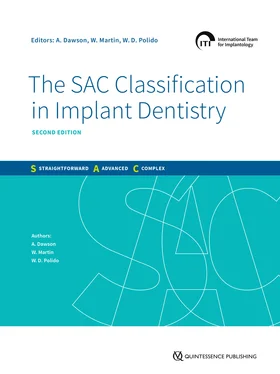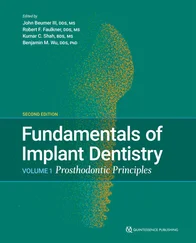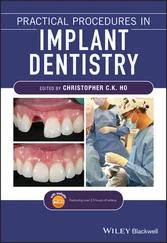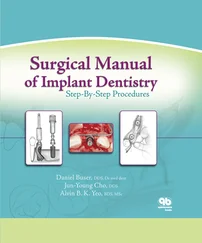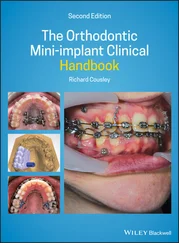Finally, the SAC classification can aid educators in developing training programs that gradually introduce increasingly more complex cases to their students, allowing an incremental development of knowledge and skill.
This book is intended to support your use of the SAC Assessment Tool that can be found at www.iti.org. Many sections of this publication are also supported by additional online information from the ITI Academy, the ITI’s e-learning platform, including learning modules and assessments, congress lectures, clinical cases, and Consensus Conference papers.
To view this additional material in full and for free, you need to be an ITI Member and logged in at www.iti.org.
Are you an ITI Member?
Please click hereto log in to the ITI Academy or scan the QR code below:

Would you like to sign up for ITI membership?
Please click hereor scan the QR code below:

Would you like to create a free ITI Academy account?
Please click hereor scan the QR code below. Please note that only selected items featured in this publication will be available to view on the ITI Academy free of charge.

As soon as you have logged in or have created your free ITI Academy account, and if you are reading the print version of this publication, you can scan QR codes like the one below and will be taken to the corresponding item in the ITI Academy.
If you are an ITI Member and reading the online version of the book on the ITI Academy, you can also click on the link in the text that accompanies each QR code:
 |
The SAC AssessmentTool distills the content of this book in an easy-to-use process that takes you through each step necessary to identify the degree of complexity and potential risk involved in individual clinical cases. To start your assessment, scan the QR code to the left or click on the link. |
CHAPTER 2: The Rationale Behind the Updated SAC Classification
A. DAWSON, C. STILWELL
Please refer to chapter 1, section 1.5for information on the prerequisites for accessing the additional online information from the ITI Academy via the QR-codes and links provided in this chapter.
Please note that to view this additional material in full and for free, you need to be an ITI Member and logged in at www.iti.org.
Case typeA class of implant-supported prostheses that share similar defining characteristics. For example, implant-supported crowns for single-tooth replacements, or short-span implant-supported fixed dental prostheses replacing three or four teeth and supported by two implants.
Process:The implant dentistry “process” is defined as the full range of issues pertaining to assessment, planning, management of treatment, and subsequent maintenance of the implant and prosthetic reconstruction; it does not merely refer to the clinical treatment procedures that are involved.
Normative classificationIn this context, “normative” relates to the classification that conforms to the norm, or standard, for a given clinical situation in implant dentistry. The normative classification relates to the most likely classification of a case type. The final classification of a specific case may differ from the normative classification for the case type as a result of individual risk factors.
Timing of implant placement and loading:Loading and placement protocols have been investigated by the ITI at its last four Consensus Conferences. Hämmerle and coworkers (Hämmerle et al, 2004) defined the timing of implant placement relative to the event of tooth removal in a site, relating this to healing events rather than a specific time frame. This classification is detailed in Table 1.
Table 1Implant placement protocols (Hämmerle et al, 2004).
| Classification |
Definition |
| Type 1 |
Implant placement immediately following tooth extraction and as part of the same surgical procedure |
| Type 2 |
Complete soft tissue coverage of the socket (typically 4 to 8 weeks) |
| Type 3 |
Substantial clinical and/or radiographic bone fill of the socket (typically 12 to 16 weeks) |
| Type 4 |
Healed site (typically more than 16 weeks) |
 |
Review article from the 3rd ITI Consensus Conference on the Placement of Implants in Extraction Socketsby Hämmerle and coworkers (2004). |
Implant loading protocols were also the subject of consensus conference reviews. At the Fourth ITI Consensus Conference, Weber and coworkers (Weber et al, 2009) defined the timing of implant loading relative to its placement. These descriptions are summarized in Table 2.
Table 2Implant loading protocols (Weber et al, 2009).
| Classification |
Definition |
| Conventional loading |
Greater than 2 months subsequent to implant placement |
| Early loading |
Between 1 week and 2 months subsequent to implant placement |
| Immediate loading |
Earlier than 1 week subsequent to implant placement |
 |
Review article from the 4th ITI Consensus Conference on Loading Protocolsby Weber and coworkers (2009). |
Most recently, the relationships between the timing of implant placement (relative to the time that the tooth in the placement site was extracted) and the timing of loading of the implant with a provisional or definitive prosthesis in partially dentate patients were addressed by Gallucci et al (Gallucci et al, 2018). The outcomes of this review, correlating the evidence for the various combinations of placement and loading protocol, are summarized in Table 3. Protocols that had multiple high-quality studies were deemed scientifically and clinically validated (SCV) and could be seen as suitable for routine use by appropriately trained and experienced clinicians. Clinically documented (CD) approaches had less support in the published literature but did possess reasonable long-term clinical documentation to allow their use in specific situations. Finally, clinically insufficiently documented (CID) protocols lacked sufficient scientific evidence and clinical documentation to be recommended for use. This review built on previous consensus meetings where definitions of the placement and loading protocols were developed.
Читать дальше
